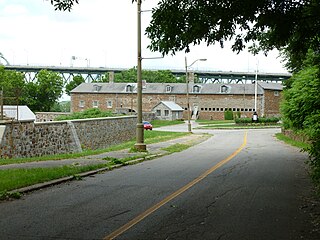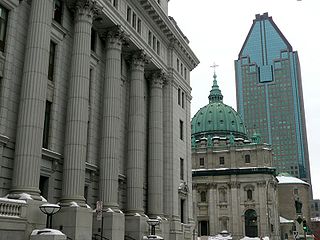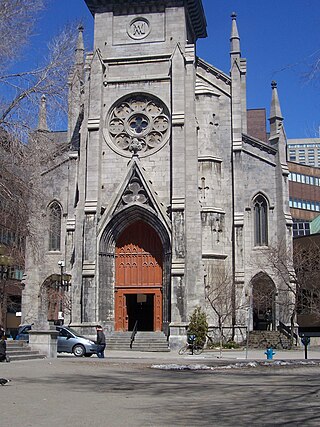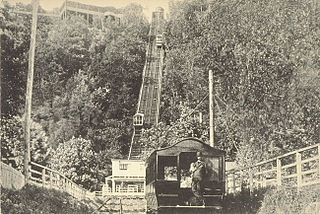
The Citadel of Montreal was a former fortress used to defend the city. It was located at what is now rue Notre-Dame between rue Bonsecours and rue Berri.
An ecomuseum is a museum focused on the identity of a place, largely based on local participation and aiming to enhance the welfare and development of local communities. Ecomuseums originated in France, the concept being developed by Georges Henri Rivière and Hugues de Varine, who coined the term ‘ecomusée’ in 1971. The term "éco" is a shortened form for "écologie", but it refers especially to a new idea of holistic interpretation of cultural heritage, in opposition to the focus on specific items and objects, performed by traditional museums.

Cégep Édouard-Montpetit is a public Francophone college in Longueuil, Quebec, Canada. Approximately 7,300 students are enrolled in the 2 campuses, the main one located in Longueuil and the École nationale d'aérotechnique in St-Hubert campuses. It is affiliated with the ACCC, and CCAA.

The Saint Helen Island Fort, a historic site on Saint Helen's Island in the city of Montreal, Quebec, was constructed in the early 1820s as an arsenal in the defensive chain of forts built to protect Canada from a threat of American invasion. Although not heavily fortified, it served an important purpose as the central artillery depot for all forts west, and in the Richelieu River Valley, known as the Valley of the Forts. These included Fort Henry and Fort Lennox. The red stone used to build the Fort is a breccia quarried on the island, which is situated in the St. Lawrence River between the island of Montreal and the south shore.

The Roman Catholic Archdiocese of Montréal is a Latin Church ecclesiastical territory or archdiocese of the Catholic Church in Canada. A metropolitan see, its archepiscopal see is the Montreal, Quebec. It includes Montreal and surrounding areas within Quebec.

The Musée d'art contemporain de Montréal (MACM) is a contemporary art museum in Montreal, Quebec, Canada. It is located on the Place des festivals in the Quartier des spectacles and is part of the Place des Arts complex.

Sherbrooke Street is a major east–west artery and at 31.3 kilometres (19.4 mi) in length, is the second longest street on the Island of Montreal, Canada. The street begins in the town of Montreal West and ends on the extreme tip of the island in Pointe-aux-Trembles, intersecting Gouin Boulevard and joining up with Notre-Dame Street. East of Cavendish Boulevard this road is part of Quebec Route 138.

Atwater Avenue is a major north–south street located in Montreal, Quebec, Canada. It links Doctor Penfield Avenue in the Ville-Marie borough to the north, and Henri Duhamel Street in the Verdun borough to the south. It is named for Edwin Atwater. The street runs through the Atwater Tunnel near the Atwater Market in Saint-Henri, before climbing and straddling the border of the city of Westmount.
Jean Talon Street is one of the longest streets on the Island of Montreal. It runs from Décarie Boulevard in the west through Anjou in the east to Galeries d'Anjou. Jean Talon was the first Intendant of New France. In the Town of Mount Royal, it is called Dresden Avenue. In the Montreal Borough of Saint-Léonard, it is colloquially known as Via Italia.

Metcalfe Street is a north–south street located in downtown Montreal, Quebec, Canada. It links Sherbrooke Street in the north and René Lévesque Boulevard in the south. It is best known for being the street on which the Sun Life Building, Mary, Queen of the World Cathedral, and other notable buildings are located. South of René Lévesque Boulevard, the street is known as Cathedral Street. The street borders the eastern side of both Dorchester Square and Place du Canada, to the south.

The Théâtre du Nouveau Monde (TNM) is a theatre company and venue located on rue Sainte-Catherine in Montreal, Quebec. Founded in 1951, it launched with the classic play L'Avare by Molière.

Doctor Penfield Avenue is a one-way eastbound street located in the Golden Square Mile neighbourhood of the borough of Ville-Marie in Montreal, Quebec, Canada. Spanning 1.7 kilometres, it begins at Pine Avenue in the east and terminates at McDougall Avenue, to the west. Doctor Penfield Avenue is named after Wilder Penfield (1891–1976), the founder of the Montreal Neurological Institute.

Saint-Jacques Cathedral was the Roman Catholic cathedral in Montreal from 1825 to 1852, named for St. James the Greater. From 1825 to 1836, it was the seat of the auxiliary bishop of Quebec in Montreal. With the creation of the Roman Catholic Diocese of Montreal in 1836, it became the cathedral of the new diocese.

The Montreal Science Centre is a science museum in Montreal, Quebec, Canada. It is located on the Quai King-Edward in the Old Port of Montreal. Established in 2000 and originally known as the iSci Centre, the museum changed its name to the Montreal Science Centre in 2002. The museum is managed by the Old Port of Montreal Corporation. The museum is home to interactive exhibitions on science and technology as well as an IMAX theatre.

The Théâtre de Quat'Sous is a Canadian theatre on Pine Avenue in the borough of Le Plateau-Mont-Royal in the city of Montreal, Quebec. Established in 1955, it is the third-oldest theatre company in Montreal after Théâtre du Rideau Vert and Théâtre du Nouveau Monde. The first Canadian play about and starring a drag queen, Hosanna by Michel Tremblay, was first performed at Théâtre de Quat'Sous in 1973.

The Sir George-Étienne Cartier National Historic Site is a historic house museum located in the Old Montreal district, of Montreal, Quebec, Canada. It commemorates the life and accomplishments of Sir George-Étienne Cartier. This reconstitution of the adjoining homes of the Cartier family features the architectural heritage left by the upper middle class of 19th-century Montreal, along with interpretive activities and theatrical performances.

École des beaux-arts de Montréal was an educational institution founded in Quebec in 1922. The Saint-Jean-Baptiste Society was instrumental in its creation. Its former Sherbrooke Street building now houses the Office québécois de la langue française.

The Mount Royal Funicular Railway, also known as the Mountain Park Funicular Railway and the Mount Royal Elevator, was a funicular railway serving Mount Royal Park in Montreal, Quebec, Canada, from 1884 to 1918.
The Dig Where You Stand movement is an international public history and adult education movement promoting public participation in research in local history, especially labor history. It began in Sweden in the 1970s and was given its shape by Sven Lindqvist in his book Gräv där du står (1978). Following the movement's success in Sweden, it was taken up in other Western countries.
















